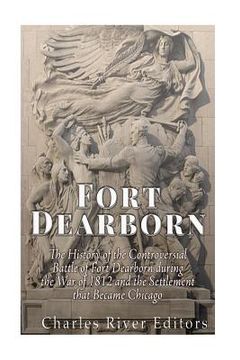Fort Dearborn: The History of the Controversial Battle of Fort Dearborn during the War of 1812 and the Settlement that Became Chicago (en Inglés)
Reseña del libro "Fort Dearborn: The History of the Controversial Battle of Fort Dearborn during the War of 1812 and the Settlement that Became Chicago (en Inglés)"
*Includes pictures *Includes an account of the Dearborn Massacre by an American soldier *Includes online resources, footnotes, and a bibliography for further reading *Includes a table of contents "We had marched half a mile, when we were attacked by 600 Kickapoo and Wynbago Indians. In the moment of trial our Confute savages joined the savage enemy, Our contest lasted ten minutes, when every man, woman and child was killed except 15. Thanks be to God I was one of those who escaped." - Walter K. Jordan, one of the men present at the Battle of Dearborn Tucked safely away in storage is an unnamed sculpture commissioned by George Pullman and sculpted by Carl Rohl-Smith depicting the "Fort Dearborn Massacre." It was originally installed near the mansion of the creator of the Pullman Palace Car Company, which manufactured railroad sleeping cars in the mid-19th century. Although placing such a sculpture at that location may initially sound weird, the Pullman mansion had been built on the site of a controversial battle that took place at an old, historic European fort along the Chicago River in Illinois in 1812. The ongoing fighting between white settlers, militias, Army units, and Native Americans not only bled into the War of 1812 but was one of the main causes of it. Many Americans chaffed at the fact that along the Northwestern frontier, the British in Canada were supporting Indian resistance to American settlement. So-called "War Hawks" from that region in Congress pushed for a declaration of war, and many hoped that a war would not only stop Indian depredations but evict the British from Canada and lead to completion of some unfinished business from the American Revolution, namely Canada joining the U.S. Although there had been treaties and seemingly cordial trading between the Native Americans and the new settlers in that area, recent fighting in nearby areas like the Battle of Tippecanoe less than a year earlier kept all sides on edge, and the British aim to maintain a barrier between America and Canada by propping up Native American tribes led to a controversial battle in the Illinois Territory at Fort Dearborn, a fort built along the Chicago River, shortly after the War of 1812 broke out. When the war came, the close proximity of British forces compelled American military officers in the area to attempt to evacuate the garrison at Fort Dearborn, but misunderstandings and a lack of time resulted in Potawatomi warriors ambushing the soldiers and several civilians before they could retreat back to Fort Wayne, Indiana. In the wake of cutting down dozens of whites, the Potawatomi laid waste to Fort Dearborn itself, and though the fighting was technically a battle, in America the Battle of Fort Dearborn was known colloquially as the Fort Dearborn Massacre. Thus, even as the conflict was relatively minor in scale, it had far-reaching implications. Although Americans wouldn't be able to rebuild the fort until after the war ended, the memory of what occurred there increased the hostility towards Native Americans and helped ensure policies of removing the area's natives were popular among settlers. The most noteworthy result was the way in which events there culminated in the Treaty of Chicago, which led to the creation of one of America's biggest cities and the westward movement of the region's native inhabitants. Fort Dearborn: The History of the Controversial Battle of Fort Dearborn during the War of 1812 and the Settlement that Became Chicago chronicles the history of the fort and examine the notorious fighting in August 1812. Along with pictures of important people, places, and events, you will learn about Fort Dearborn like never before, in no time at all.

